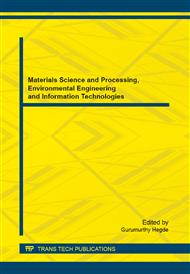p.521
p.528
p.534
p.538
p.543
p.547
p.551
p.555
p.559
Growth and Physiological Effects of Model Acid Rain and Lead Contamination to Tall Fescue Seedlings
Abstract:
In order to explore phytoremediation and physiological effect of plant to heavy metal, physiological and biochemical changes of tall fescue seedlings were comparatively analyzed when they were contaminated by lead at different times and concentrations. The results showed that: At three lead concentrations, superoxide dismutase (SOD) and peroxidase (POD) activity in tall fescue increased initially and then decreased overall with stress times. Change of POD is slower. It indicated that lead can rapid induce tall fescue protecting enzyme activity at low concentrations or in a short period. Malondialdehyde (MDA) contents were positively correlated with stress time and stress concentrations, which indicated that with the increase of stress concentration and time, membrane lipid peroxidation strengthen. Changes of chlorophyll total concentration increased first and then decreased at low concentration (500 and 1000 mg·L-1), and continued to decline at high concentration. It indicated tall fescue may adapt low lead stress by increasing chlorophyll to, and lose regulation at high concentrations.Proline content decreased initially and then increased with time at 500,1000 mg·L-1, however, it was opposite at 1500 mg·L-1. They were higher than controls, indicating that osmotic adjustment ability enhanced after lead stress. Changes of soluble sugar content were down - up - down with times at three concentrations, eventually they reduced significantly. Therefore, in the process of lead stress, changes of physiological characteristics in tall fescue showed their actively adapt and resistance at low stress, and tolerance and injury at high stress.
Info:
Periodical:
Pages:
543-546
Citation:
Online since:
October 2014
Authors:
Keywords:
Price:
Сopyright:
© 2014 Trans Tech Publications Ltd. All Rights Reserved
Share:
Citation:


